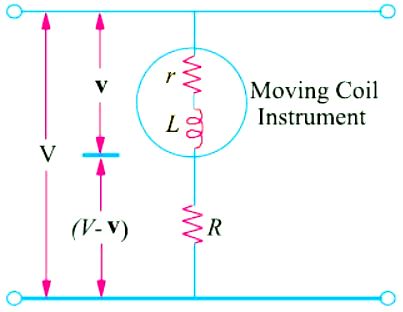Extension of Range by Shunts and Multipliers
(i) As Ammeter :
The Extension of range by shunts and multipliers of the moving-iron instrument, when used as an ammeter, can be extended by using a suitable shunt across its terminals. So far as the operation with direct current is concerned, there is no trouble, but with alternating current, the division of current between the instrument and shunt changes with the change in the applied frequency. For A.C. work, both the inductance and resistance of the instrument and shunt have to be taken into account.
![]()
where I = line current ; i = full-scale deflection current of the instrument.
(ii) As Voltmeter. The range of this instrument, when used as a voltmeter, can be extended or multiplied by using a high non-inductive resistance R connected in series with it, as shown in Figure (A). This series resistance is known as ‘multiplier’ when used on D.C. circuits. Suppose, the range of the instrument is to be extended from ν to V. Then obviously, the excess voltage of (V − ν) is to be dropped across R. If i is the full-scale deflection current of the instrument, then

AdBlock-2

Hence, greater the value of R, greater is the extension in the voltage range of the instrument. For D.C. work, the principal requirement of R is that its value should remain constant i.e. it should have low temperature-coefficient. But for A.C. work it is essential that total impedance of the voltmeter and the series resistance R should remain as nearly constant as possible at different frequencies. That is why R is made as non-inductive as possible in order to keep the inductance of the whole circuit to the minimum. The frequency error introduced by the inductance of the instrument coil can be compensated by shunting R by a capacitor C as shown in Figure (B). In case r<<R, the impedance of the voltmeter circuit will remain practically constant (for frequencies upto 1000 Hz) provided.

![]()
Read article – inductance
Visit NCERTplanet.com for NCERT solutions and Textbook downloads




